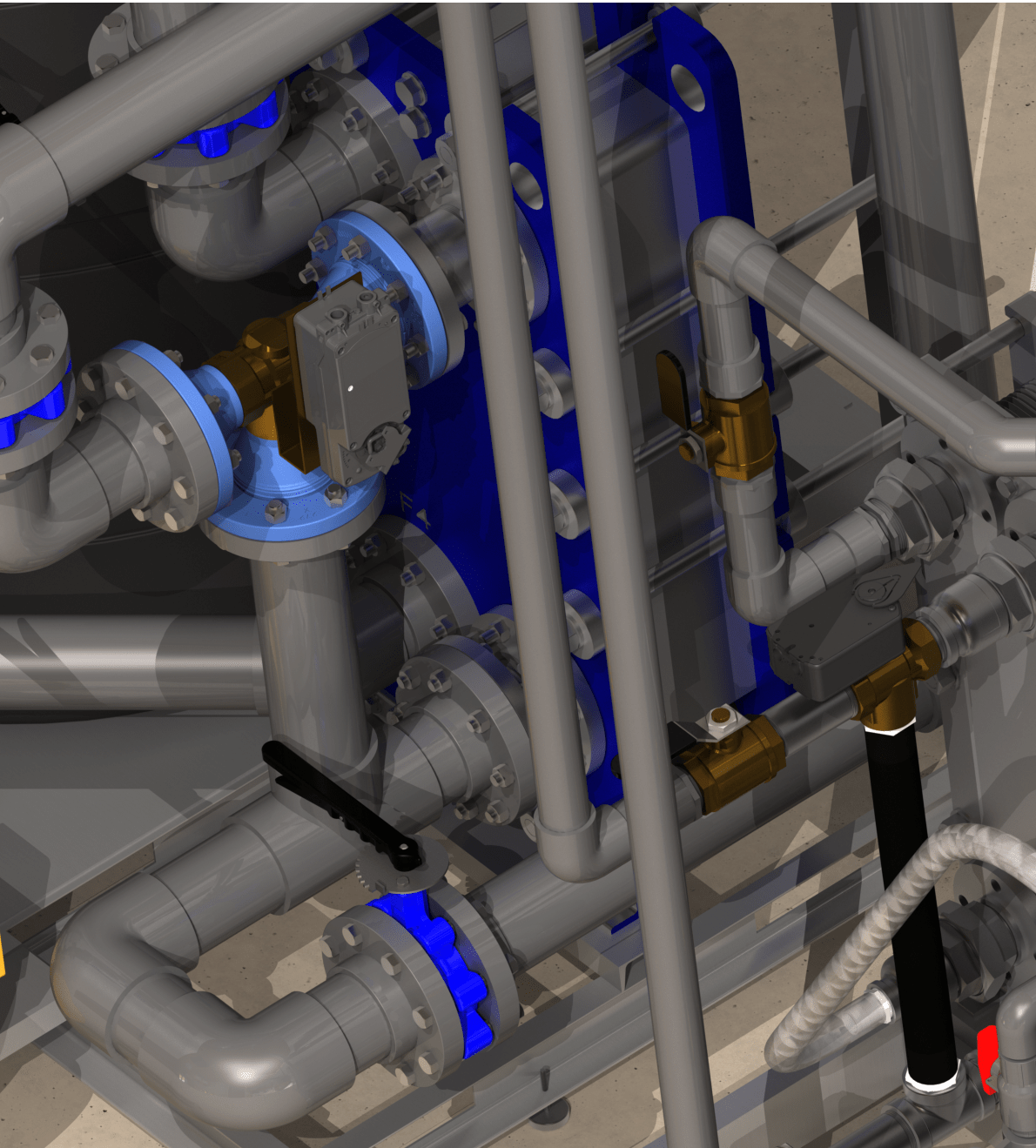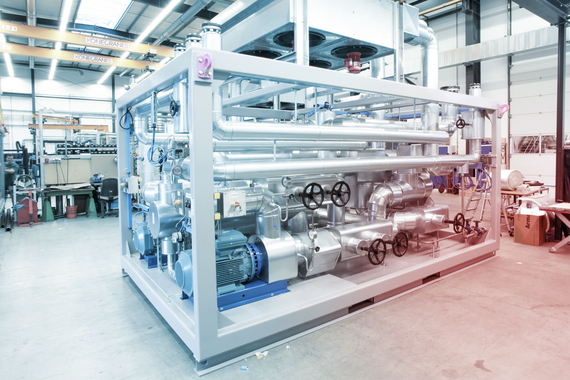The Role of Heat Transfer Systems in Sustainable Energy Solutions for the Future
Heat transfer systems are important in the quest for sustainable energy solutions. They enhance thermal power administration, improving the performance of eco-friendly technologies. By utilizing devices like transmission, convection, and radiation, these systems reduce energy losses. Their function in solar thermal and geothermal applications is particularly significant. As developments emerge, the potential for further advancements raises important concerns concerning future power techniques. What advancements will shape the landscape of lasting energy?
Comprehending Heat Transfer Equipments

The Value of Thermal Power Management
Effective thermal power monitoring is necessary for maximizing energy effectiveness and lessening waste in different systems. By regulating temperature level and maximizing Heat transfer procedures, organizations can noticeably minimize energy intake and operational costs. Reliable management entails the execution of sophisticated technologies and practices that keep track of and control thermal problems within systems, making sure that energy sources are utilized effectively. Furthermore, correct thermal energy monitoring contributes to reducing greenhouse gas discharges, lining up with international sustainability goals. It additionally improves system integrity and performance, bring about boosted item top quality and longer devices life-span. Eventually, focusing on thermal energy management is a vital step in the direction of creating a lot more lasting energy options and cultivating an accountable strategy to energy usage in commercial and residential contexts.
Applications of Heat Transfer in Renewable Energy
While different renewable resource sources guarantee sustainability, the efficient application of Heat transfer plays an important function in their performance. In wind energy systems, Heat transfer is used for wind turbine part cooling, enhancing performance and durability. Geothermal power counts on reliable Heat exchange between the earth's subsurface and the fluid distributing in the system, maximizing energy extraction. Biomass energy processes likewise gain from Heat transfer, as it assists in transforming natural products into usable fuel with pyrolysis and gasification. Furthermore, in hydropower, preserving suitable temperature levels in storage tanks can boost power result. Each of these applications shows the essential importance of Heat transfer systems in boosting eco-friendly energy modern technologies, inevitably adding to a more sustainable energy future.
Enhancing Solar Thermal Power Efficiency
As solar thermal power systems continue to evolve, enhancing their performance has actually come to be crucial for taking full advantage of energy output. Advancements in Heat transfer innovations, such as enhanced thermal storage materials and cutting-edge Heat exchangers, play a considerable role in enhancing performance. By utilizing innovative products that have remarkable thermal conductivity, systems can catch and transfer Heat better. Furthermore, integrating monitoring systems that comply with the sun's course warranties that collection agencies receive ideal solar direct exposure throughout the day. Using nanotechnology in solar absorbers can further increase power absorption rates. In addition, integrating computerized control systems assists take care of and control temperature levels energy circulation effectively, leading to lowered losses and enhanced overall system effectiveness. These enhancements lead the way for more sustainable solar thermal energy remedies in the future.
Geothermal Home Heating: A Lasting Service
Geothermal home heating presents a practical choice for lasting power, supplying substantial environmental advantages through decreased greenhouse gas exhausts. Its effectiveness and cost-effectiveness make it an attractive alternative to typical heater. However, challenges connected to execution needs to be addressed to maximize its prospective influence.
Ecological Benefits of Geothermal
Although standard home heating techniques add significantly to greenhouse gas discharges, geothermal heating provides a compelling alternative that minimizes environmental impact. By harnessing the Planet's interior Heat, geothermal systems utilize a renewable resource resource, significantly decreasing dependence on fossil gas. This approach produces minimal carbon exhausts, making it a cleaner choice for business and property heating. In addition, geothermal systems advertise energy performance, as they need much less energy contrasted to traditional heater. DVS Heat Transfer Systems. The usage of geothermal energy additionally assists in decreasing air contamination, enhancing neighborhood air high quality and public health. As a lasting option, geothermal heating sustains climate adjustment mitigation initiatives, positioning itself as a vital part in the shift in the direction of a greener future
Effectiveness and Cost-Effectiveness
How does geothermal home heating measure up in terms of performance and cost-effectiveness contrasted to traditional furnace? Geothermal home heating demonstrates premium effectiveness, often accomplishing a coefficient of efficiency (COP) of 3 to 5, suggesting it produces three to 5 devices of Heat for each device of electrical energy taken in. This performance translates right into reduced operating expense, particularly in areas with stable geothermal resources. First installation expenses can be more than standard systems; however, long-lasting cost savings on energy expenses and lowered maintenance expenses can balance out these ahead of time investments. Additionally, numerous federal governments incentivize geothermal systems via rebates and tax credit histories, boosting their cost-effectiveness. On the whole, geothermal home heating arises as a sustainable and financially viable option to more conventional heating options.
Execution Obstacles and Solutions
Countless obstacles can restrain the extensive application of geothermal furnace, in spite of their clear benefits as a sustainable energy service. High initial setup costs typically prevent house owners and financiers, making financing a significant barrier. Additionally, the geographical limitations of suitable geothermal websites limit availability in specific regions. Neighborhood laws and allowing processes can also complicate job advancement, resulting in hold-ups. In addition, public recognition and understanding of geothermal systems continue to be reduced, hindering approval. To deal with these obstacles, targeted education and learning projects can boost public understanding, while government motivations might reduce financial problems. Teaming up with regional authorities to streamline laws may help with smoother job approvals, ultimately promoting the fostering of geothermal heating as a viable, lasting energy alternative.
Developments in Heat Transfer Technologies
Technologies in Heat transfer modern technologies play a crucial duty in improving power efficiency and sustainability. Advanced Heat exchangers and stage change products are at the center of these growths, providing substantial enhancements in thermal management. These modern technologies not only enhance power use however likewise add to reducing ecological impact in numerous applications.
Advanced Heat Exchangers
Advanced Heat exchangers play an essential role in enhancing power performance across different applications in lasting power solutions. These devices assist in the transfer of Heat in between two or more fluids, markedly decreasing energy DVS Heat Transfer Systems usage in procedures such as commercial home heating, air conditioning, and power generation. Innovations in materials and style, such as using nanofluids and small configurations, have actually caused boosted thermal performance and lowered dimension needs. Additionally, developments in digital tracking and control systems enable for enhanced operation, more raising performance. By minimizing waste Heat and taking full advantage of power healing, advanced Heat exchangers add to reduce carbon footprints and support the shift towards eco pleasant modern technologies. Their proceeded growth is crucial for accomplishing worldwide energy sustainability objectives.
Stage Adjustment Materials
The combination of phase adjustment products (PCMs) into Heat transfer modern technologies stands for a considerable development in energy management and effectiveness. PCMs soak up and release thermal power during their stage modifications, allowing effective temperature level guideline in building products and energy systems. By saving excess Heat during peak durations and launching it when demand rises, PCMs contribute to pack moving and energy preservation - DVS Heat Transfer Systems. This ability enhances the performance of renewable power systems, especially in solar thermal applications. Additionally, PCMs can enhance the thermal comfort of interior atmospheres, reducing reliance on standard heating and cooling down techniques. As developments in PCM solutions remain to arise, their function in sustainable power solutions is positioned to grow, using promising opportunities for future research and application

Future Potential Customers for Heat Transfer in Sustainable Power
As the need for lasting power solutions continues to climb, the duty of Heat transfer systems is ending up being progressively vital fit future innovations. Developments in designs and products are anticipated to improve effectiveness in Heat transfer, decreasing power losses in different applications. The integration of advanced thermal storage space systems, such as phase change products and thermochemical storage, will allow far better management of energy sources. Research study right into nanofluids and biomimetic Heat exchangers may further maximize thermal performance. The adoption of clever innovations will certainly enable for real-time tracking and flexible control of Heat transfer procedures. These improvements are poised to substantially add to the overall effectiveness and sustainability of power systems, paving the means for a more energy-efficient future.
Regularly Asked Concerns
Just How Can Individuals Apply Heat Transfer Equipment at Home?

People can implement Heat transfer systems in the house by setting up energy-efficient devices, utilizing glowing heating, and maximizing insulation. These steps boost energy effectiveness, lower costs, and promote lasting methods in property environments.

What Are the Expenses Associated With Mounting Heat Transfer Solutions?
The costs linked with mounting Heat transfer systems vary extensively, normally including equipment, installment labor, and upkeep. Elements such as system kind, home dimension, and local laws substantially influence the total expense included.
Are There Federal Government Rewards for Heat Transfer System Installations?
Federal government incentives for Heat transfer system installations differ by area and can include tax obligation grants, discounts, and credit histories. These economic benefits intend to motivate fostering, eventually advertising power efficiency and lowering environmental effect within areas.
How Do Heat Transfer Systems Effect Power Bills?
Heat transfer systems significantly affect energy bills by enhancing energy effectiveness. By boosting the transfer of Heat, these systems reduce energy usage, bring about lower utility expenses and developing a more sustainable technique to power management.
What Maintenance Is Required for Heat Transfer Solutions?
Upkeep for Heat transfer systems includes routine assessments, cleansing of parts, inspecting fluid levels, guaranteeing correct insulation, and replacing worn parts. These tasks help preserve effectiveness, stop failures, and lengthen the system's functional life expectancy.
These systems assist in the motion of thermal energy from one medium to another, allowing the transfer of Heat for air conditioning, home heating, or power generation objectives. Geothermal power depends on efficient Heat exchange in between the earth's subsurface and the fluid flowing in the system, making the most of energy extraction. In addition, geothermal systems advertise energy efficiency, as they require much less energy contrasted to standard home heating systems. Advanced Heat exchangers play a necessary function in enhancing energy performance across numerous applications in lasting energy solutions. Heat transfer systems significantly influence power expenses by enhancing energy efficiency.